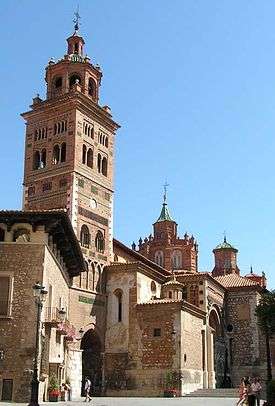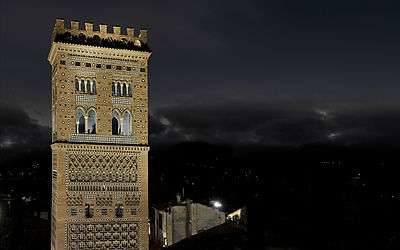Teruel
| Teruel | |||
|---|---|---|---|
| Municipality | |||
| |||
 Teruel Location in Spain | |||
| Coordinates: 40°20′37″N 1°6′26″W / 40.34361°N 1.10722°WCoordinates: 40°20′37″N 1°6′26″W / 40.34361°N 1.10722°W | |||
| Country |
| ||
| Autonomous community |
| ||
| Province | Teruel | ||
| Comarca | Comunidad de Teruel | ||
| Judicial district | Teruel | ||
| Founded | 1171 | ||
| Government | |||
| • Alcalde | Emma Buj (Partido Popular de Aragón) | ||
| Area | |||
| • Total | 440.41 km2 (170.04 sq mi) | ||
| Elevation | 915 m (3,002 ft) | ||
| Population (2009) | |||
| • Total | 35,396 | ||
| • Density | 80/km2 (210/sq mi) | ||
| Demonym(s) | Turolense | ||
| Time zone | CET (UTC+1) | ||
| • Summer (DST) | CEST (UTC+2) | ||
| Postal code | 44001 - 44003 | ||
| Dialing code | 978 | ||
| Official language(s) | Spanish | ||
| Website | Official website | ||
Teruel (Spanish pronunciation: [teˈɾwel]) is a town in Aragon, located in eastern Spain, and is also the capital of Teruel Province. It has a population of 35,675 in 2014[1] making it the least populated provincial capital in the country. It is noted for its harsh climate (hot in summer and very cold in winter), its renowned jamón serrano (cured ham), its pottery, its surrounding archaeological sites, rock outcrops containing some of the oldest dinosaur remains of the Iberian Peninsula, and its famous events: La Vaquilla del Ángel [2] during the weekend closer more to the 10th July (Friday, Saturday, Sunday and Monday), and "Bodas de Isabel de Segura" around the third weekend of February.
Teruel is regarded as the "town of mudéjar" (Moorish-influenced architecture) due to numerous buildings designed in this style. All of them are comprised in the Mudéjar Architecture of Aragon which is a World Heritage Site by the UNESCO.
Teruel's remote and mountainous location 915 metres (3,002 feet) above sea level and its low population has led to relative isolation within Spain. A campaign group with the slogan Teruel existe ("Teruel exists") was founded in 1999 to press for greater recognition and investment in the town and the province. Due in part to the campaign, transport connections to Teruel are being greatly improved with the construction of a motorway between Zaragoza and Sagunto, large parts of which are now open. However, Teruel remains the only provincial capital in peninsular Spain without a direct railway link to the capital, Madrid.
Climate
According to the Köppen climate classification, Teruel has a humid subtropical (Cfa) bordering on a cold semi-arid climate (BSk). Summer temperatures are mild, although there is much daily variation, and winters are cold, with low minimum temperatures sometimes dropping to −10 °C (14.0 °F). The lowest amount of rainfall is in winter and the greatest falls at the end of spring and autumn.
The temperature records recorded at the Observatoire de Teruel 40.2 °C (104.4 °F) on August 10, 2012 and −19 °C (−2.2 °F) on December 26, 2001.
| Climate data for Teruel 918m (1986-2010) | |||||||||||||
|---|---|---|---|---|---|---|---|---|---|---|---|---|---|
| Month | Jan | Feb | Mar | Apr | May | Jun | Jul | Aug | Sep | Oct | Nov | Dec | Year |
| Record high °C (°F) | 21.2 (70.2) |
23.8 (74.8) |
28.0 (82.4) |
30.1 (86.2) |
35.8 (96.4) |
38.0 (100.4) |
39.0 (102.2) |
40.2 (104.4) |
36.7 (98.1) |
31.0 (87.8) |
25.1 (77.2) |
20.3 (68.5) |
40.2 (104.4) |
| Average high °C (°F) | 9.7 (49.5) |
12.1 (53.8) |
15.7 (60.3) |
17.0 (62.6) |
21.8 (71.2) |
27.0 (80.6) |
31.3 (88.3) |
30.7 (87.3) |
25.3 (77.5) |
19.3 (66.7) |
13.4 (56.1) |
9.9 (49.8) |
19.4 (66.9) |
| Daily mean °C (°F) | 3.7 (38.7) |
5.3 (41.5) |
8.2 (46.8) |
9.9 (49.8) |
14.3 (57.7) |
18.7 (65.7) |
22.2 (72) |
22.0 (71.6) |
17.6 (63.7) |
12.7 (54.9) |
7.2 (45) |
4.2 (39.6) |
12.2 (54) |
| Average low °C (°F) | −2.3 (27.9) |
−1.6 (29.1) |
0.8 (33.4) |
2.8 (37) |
6.8 (44.2) |
10.5 (50.9) |
13.0 (55.4) |
13.2 (55.8) |
9.9 (49.8) |
6.0 (42.8) |
0.9 (33.6) |
−1.4 (29.5) |
4.9 (40.8) |
| Record low °C (°F) | −16.2 (2.8) |
−12.8 (9) |
−10.6 (12.9) |
−5.3 (22.5) |
1.4 (34.5) |
1.8 (35.2) |
4.6 (40.3) |
3.0 (37.4) |
0.4 (32.7) |
−4.0 (24.8) |
−12.2 (10) |
−19.0 (−2.2) |
−19.0 (−2.2) |
| Average precipitation mm (inches) | 19 (0.75) |
15 (0.59) |
21 (0.83) |
39 (1.54) |
57 (2.24) |
46 (1.81) |
26 (1.02) |
34 (1.34) |
36 (1.42) |
47 (1.85) |
22 (0.87) |
19 (0.75) |
378 (14.88) |
| Source #1: Agencia Estatal de Meteorología[3] | |||||||||||||
| Source #2: Agencia Estatal de Meteorología[4] | |||||||||||||
History

Teruel was founded in 1171 by Alfonso II. In the Middle Ages Teruel possessed a prominent Jewish community, which was robust during the centuries Muslims were in power and enjoyed several privileges. Later on after the Christian reconquest of Spain, the Jewish community paid a yearly tax of 300 sueldos (in the 14th century). Its members were engaged in commerce and industry, especially in wool-weaving. During the persecutions of 1391 many of them were killed, while others accepted Christianity in order to save their lives.[5]
Teruel was fought over in the Spanish Civil War and suffered much destruction. The Battle of Teruel in December 1937-February 1938, was one of the bloodiest of the war. The town changed hands several times, first falling to the Republicans and eventually being re-taken by the Nationalists. In the course of the fighting, Teruel was subjected to heavy artillery and aerial bombardment. The two sides suffered up to 140,000 casualties between them in the three-month battle. The Nationalists won a decisive victory.
Main sights

.jpg)
.jpg)
The beauty of the town's cultural inheritance, which has some Islamic influence, has been recognised by UNESCO, which includes four churches in the World Heritage Site Mudéjar Architecture of Aragon, notably the town's ornate cathedral in the Mudéjar style.[6]
One of Teruel's best known monuments is very small statue of a bull on top of a tall column, known as El Torico ("the little bull"). It is located in the main square, Plaza Carlos Castell, more commonly known as the Plaza del Torico in the middle of the town center.
Other sights include:
- Torre de El Salvador (14th century), in mudéjar style
- Cathedral: Catedral de Santa María de Teruel, in mudéjar style
- San Pedro, a notable mudéjar church (16th century) with a tower similar to that of the cathedral. It includes a mausoleum, Mausoleo de Los Amantes, housing the mummified bodies of Isabel de Segura (a wealthy woman) and Diego de Marcilla (a poor man who battled at Crusades to earn some money with the intention to return to get married with Isabel) whose love ended tragically. This story is known as los amantes de Teruel and has inspired writers (for example Hartzenbusch) and an opera composed by Tomás Bretón.
- Church of La Merced, with a bell tower in mudéjar style (the upper sector added later in Baroque style).
- Church of San Salvador (17th century), with one of the most outstanding mudéjar towers. It houses a 14th-century wooden sculpture of Christ.
- Church of San Martín (17th century).
- Torre de San Martín (14th century), in mudéjar style
- Church of San Miguel (12th century), remade in the 17th century in Baroque style.
- Castillo de Alambes, a 15th-century fortification built over the Arabic Alcazar.
- Casa El Torico, Casa Ferrán and Casa La Madrileña, 1910s liberty style houses
- Palace of the Marquis of Tosos (17th century)
- The Gothic church of St. Francis (1391–1492). It has a single nave with chapels covered by a ribbed vault with no crossing.
- Los Arcos, an aqueduct with two orders of arcade from 1538.
On the outskirts of Teruel is Dinópolis Teruel, a combined theme park and museum centred on dinosaurs. Promoted as a paleontological park, it includes a life-size robotic model of a Tyrannosaurus rex. Dinópolis also owns three other museums in the surrounding area, which display the remains of dinosaurs discovered in the region.. The chimney of the Teruel Power Plant is one of the tallest freestanding structures in Western Europe.
Transportation
The city buses are run by Grupo Autobuses Jimenez.
Notable people
- Luis Royo
- David Civera
- Manuel Macías y Casado, general and military governor
See also
References
- ↑ Instituto Nacional de Estadística, Cifras oficiales de población resultantes de la revisión del Padrón municipal a 1 de enero de 2014, Resumen por Capitales de provincias
- ↑ Photographer/Writer, Lori Needleman (2016-06-29). "Move Over San Fermín: There's Another Fiesta In Spain -- La Vaquilla Del Ángel". The Huffington Post. Retrieved 2016-11-27.
- ↑ "Valores climatológicos normales. Teruel". Aemet.es. Retrieved 17 March 2015.
- ↑ http://www.aemet.es/es/serviciosclimaticos/datosclimatologicos/efemerides_extremos*?w=0&k=arn&l=8368U&datos=det&x=8368U&m=13&v=todos
- ↑ Jewish Encyclopedia
- ↑ Alejandro Lapunzina (2005). Architecture of Spain. Greenwood. p. 37.
External links
| Wikimedia Commons has media related to Teruel. |
| Wikivoyage has a travel guide for Teruel. |
| Wikisource has the text of a 1911 Encyclopædia Britannica article about Teruel. |
- La Vaquilla del Ángel
- Teruel existe
- Teruel Travelguide and Hotel bookings in English
- The main page of Teruel's Town Hall
- English World Heritage Centre
- Flickr Photos
- Instituto Nacional de Estadística

.svg.png)
